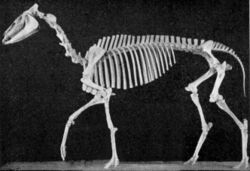Biology:Hypohippus
| Hypohippus | |
|---|---|

| |
| Hypohippus osborni skeleton | |
| Scientific classification | |
| Domain: | Eukaryota |
| Kingdom: | Animalia |
| Phylum: | Chordata |
| Class: | Mammalia |
| Order: | Perissodactyla |
| Family: | Equidae |
| Subfamily: | †Anchitheriinae |
| Genus: | †Hypohippus Leidy, 1858 |
| Species | |
| |
Hypohippus (Greek: "under" (hypos), "horse" (hippos)[1]) is an extinct genus of three-toed horse, which lived 17–11 million years ago.[2] It was the largest anchitherine equid about the size of a modern domestic horse, at 403–600 kg (888–1,323 lb)[3][4] and 1.8 m (5.9 ft) long. It was a long-necked, high-shouldered browser with sub-hypsodont, lophodont (rhino-like) dentition, that fed on the tough vegetation of forest understory and shrubs. Its deep preorbital fossae and retraction of the nasal notch hint at the presence of a long, muscular and prehensile upper lip that would aid during selective browsing. Overall its ecology would have been more comparable to modern okapi than to grazing horses.[5] Fossils of it have been found in Nebraska, Colorado, and Montana.[6][7]
References
- ↑ "Glossary. American Museum of Natural History". https://research.amnh.org/paleontology/perissodactyl/concepts/glossary.
- ↑ Janis, C. M.; Damuth, J.; Theodor, J. M. (2002). "The origins and evolution of the North American grassland biome: The story from the hoofed mammals". Palaeogeography, Palaeoclimatology, Palaeoecology 177 (1–2): 183–198. doi:10.1016/S0031-0182(01)00359-5. Bibcode: 2002PPP...177..183J.
- ↑ Bruce J. MacFadden (1992). Fossil Horses: Systematics, Paleobiology, and Evolution of the Family Equidae. Cambridge University Press. p. 284. ISBN 0521477085. https://books.google.com/books?id=K1upTamSEW0C&dq=megahippus+kg&pg=PA284. Retrieved 21 September 2022.
- ↑ Christine M. Janis (1998). Evolution of Tertiary Mammals of North America: Volume 1, Terrestrial, Carnivores, Ungulates and Ungulate-like mammals. Cambridge University Press. p. 545. ISBN 9780521355193. https://books.google.com/books?id=I-RgojcDyWYC&dq=Megahippus&pg=PA545. Retrieved 21 September 2022.
- ↑ Evans, J. W.; Bennett, Debb (2008). The Elsevier World Animal Science Encyclopedia. pp. 1–37. https://www.equinestudies.org/_files/ugd/7f2126_dcec973014384bb1b74e87eaf043b20d.pdf.
- ↑ Hypohippus
- ↑ "Hypohippus" (in en-US). 2018-02-16. https://www.floridamuseum.ufl.edu/fossil-horses/gallery/hypohippus/.
Wikidata ☰ Q741886 entry
 |



